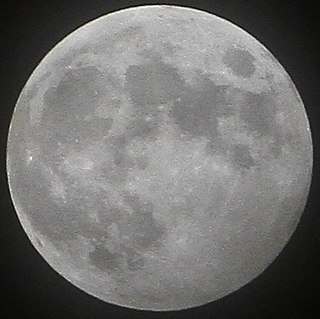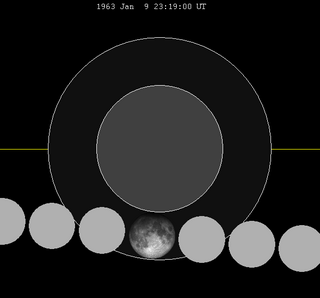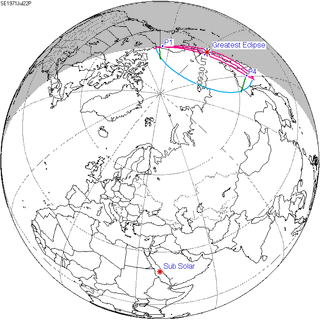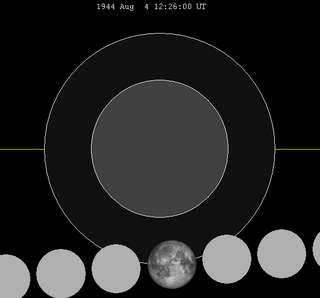The topic of this article may not meet Wikipedia's general notability guideline .(January 2022) |

A penumbral lunar eclipse took place on Thursday, July 6, 1944.
The topic of this article may not meet Wikipedia's general notability guideline .(January 2022) |

A penumbral lunar eclipse took place on Thursday, July 6, 1944.
| Descending node | Ascending node | |||||
|---|---|---|---|---|---|---|
| Saros | Date Viewing | Type Chart | Saros | Date Viewing | Type Chart | |
| 109 | 1944 Jul 06  | Penumbral | 114 | 1944 Dec 29  | Penumbral | |
| 119 | 1945 Jun 25  | Partial | 124 | 1945 Dec 19  | Total | |
| 129 | 1946 Jun 14  | Total | 134 | 1946 Dec 08  | Total | |
| 139 | 1947 Jun 03  | Partial | 144 | 1947 Nov 28  | Penumbral | |

A lunar eclipse is an astronomical event that occurs when the Moon moves into the Earth's shadow, causing the Moon to be darkened. Such alignment occurs during an eclipse season, approximately every six months, during the full moon phase, when the Moon's orbital plane is closest to the plane of the Earth's orbit.

A penumbral lunar eclipse took place on November 20, 2002, the last of three lunar eclipses in 2002.

A penumbral lunar eclipse took place on Sunday, December 30, 2001, the last of three lunar eclipses in 2001.

A penumbral lunar eclipse took place on 18–19 October 2013, the last of three lunar eclipses in 2013.

A penumbral lunar eclipse took place on Sunday, January 31, 1999, the first of two lunar eclipses in 1999.

A partial lunar eclipse occurred on the 16 and 17 July 2019. The Moon was covered 65.31% by the Earth's umbral shadow at maximum eclipse.
A partial lunar eclipse will take place on Saturday, 28 October 2023.
A penumbral lunar eclipse will take place on Monday, March 25, 2024. It will be visible to the naked eye as 95.57% of the Moon will be immersed in Earth's penumbral shadow.

A penumbral lunar eclipse will take place on May 7, 2031.

A total lunar eclipse took place on Monday, May 13, 1957, the third of fourteen total lunar eclipses of Lunar Saros 130. The Moon was plunged into darkness for 1 hour and 18 minutes, in a deep total eclipse which saw the Moon 30% of its diameter inside the Earth's umbral shadow. The visual effect of this depends on the state of the Earth's atmosphere, but the Moon may have been stained a deep red colour. The partial eclipse lasted for 3 hours and 32 minutes in total.

A penumbral lunar eclipse took place on Sunday, July 15, 1973, the third of four lunar eclipses in 1973, the first was a penumbral lunar eclipse on Thursday, January 18, the second was a penumbral lunar eclipse on Friday, June 15, and the last being with a partial lunar eclipse on Monday, December 10.

A partial lunar eclipse took place on Monday, June 14, 1965. At maximum eclipse, a small bite out of the Moon should have been visible. The eclipse lasted for 1 hour and 40 minutes, with just 18% of the Moon in shadow at maximum.

A penumbral lunar eclipse took place on Wednesday, January 9, 1963, the first of three lunar eclipses in 1963.

A partial lunar eclipse took place on Thursday, March 2, 1961, the first of two partial lunar eclipses in 1961.

A total lunar eclipse took place on Sunday, July 26, 1953.

A total lunar eclipse will take place on April 26, 2051.

A partial solar eclipse occurred on July 22, 1971. This was the 70th and final solar eclipse from Solar Saros 116.

A penumbral lunar eclipse took place on Friday, December 29, 1944. In a rare total penumbral eclipse, the entire Moon was partially shaded by the Earth, and the shading across the Moon should have been quite visible at maximum eclipse. The penumbral phase lasted for 4 hours and 27 minutes in all, though for most of it, the eclipse was extremely difficult or impossible to see.

A penumbral lunar eclipse took place on Friday, August 4, 1944.